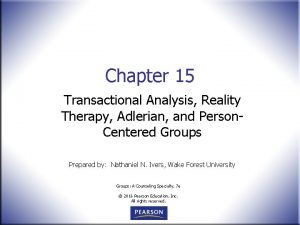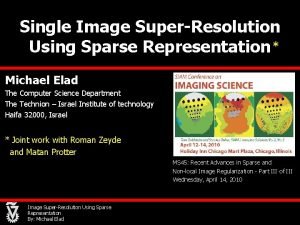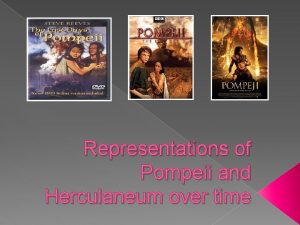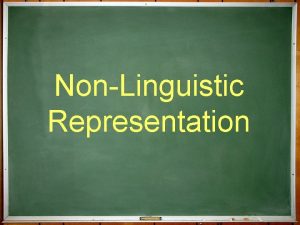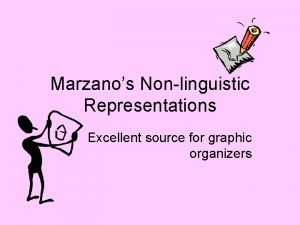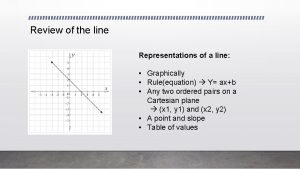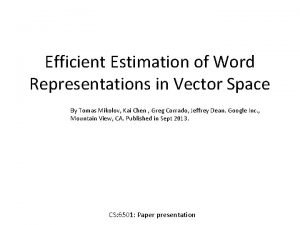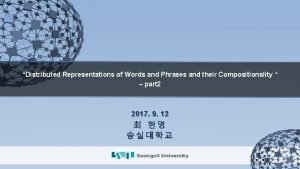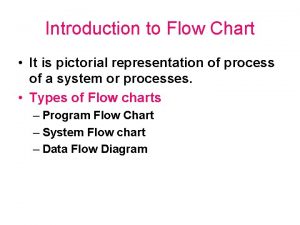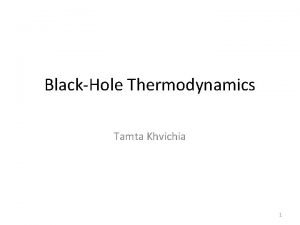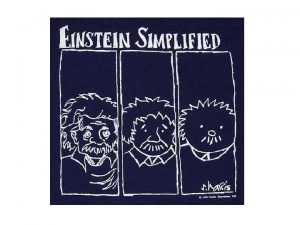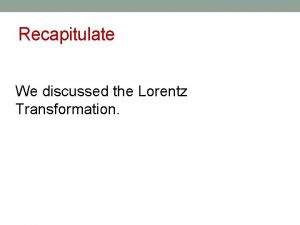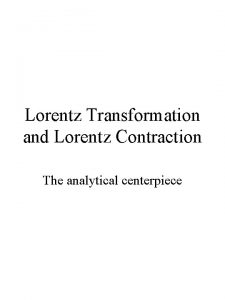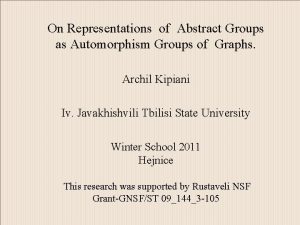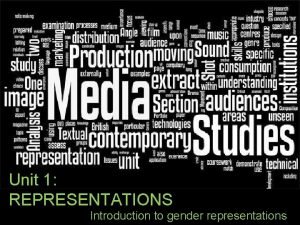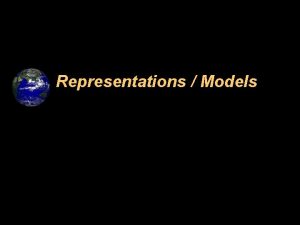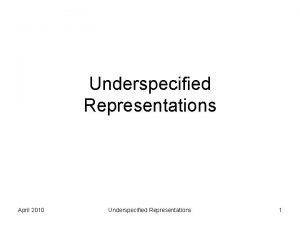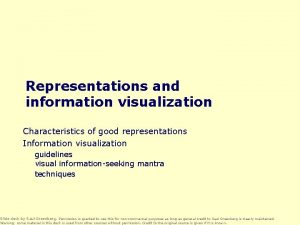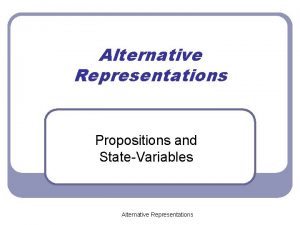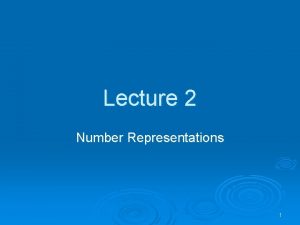Representations of Lorentz groups Tamta Khvichia LORENTZ GROUP















- Slides: 15

Representations of Lorentz groups Tamta Khvichia

LORENTZ GROUP � Lorentz group O(1, 3) � Infinitesimal generators � Associated Lie algebra : � Proper orthochronous or restricted Lorentz group: (Excludes parity and time-reversal transformations ) � A generic element Λ of the Lorentz group: tensor of parameters:

Finite-dimensional representations � The Lorentz group has both finite-dimensional and infinite -dimensional representations � The Lorentz group is non-compact � Finite-dimensional representations are not unitary (the generators are not Hermitian) �Trivial representation � One-dimensional (0, 0): representation Acts on a one-dimensional vector space Acts on Lorentz scalars

Vector representation ( 1/2 , 1/2 ) fundamental representation � four-dimensional representation � 4 -vector representation � Acts on a four-dimensional vector space � Acts on Lorentz four-vectors � Explicit form of the matrices � Matrices of the vector representation are the SO+ (1, 3) matrices � where is the usual Lorentz transformation matrix � The vector representation is the fundamental representation of the Lorentz group

Tensor representations � Tensor representations are given by the direct (tensor) product of copies of the vector representation � For example: (2, 0) tensors - tensors with two contravariant (upper) indices element of the Lorentz group Λ will be represented by a (16× 16) matrix � Act on the set of tensors of a given rank � Representations for higher-rank tensors are constructed in the same way, with additional copies of the vector representation in the direct product

Adjoint representation (constructed from the structure constants of the group) � The Lie algebra can be written as: � Structure constants � If we define (16× 16) matrices Matrices satisfy the Lorentz algebra � generators of the Lorentz group are antisymmetric 6 independent generators (corresponding to the 3 rotations and 3 boosts) � The Lie algebra can be written as: a, b, c = 1, . . . , 6 where With this notation, the adjoint representation is composed of (6× 6) matrices

Spinorial representations (1/2 , 0) � Spinorial representations of the Lie group SO(n, m) are given by representations of the double cover of SO(n, m) called the spin group Spin(n, m) � Double cover of the restricted Lorentz group : SL(2, C) is the set of complex 2× 2 matrices with Det =1 � Fundamental representation of SL(2, C) is a spinorial representation of � Acts on two-component objects (complex 2× 1 column vectors) called left-handed Weyl spinors � Representations is 2 -dimensional

Spinorial representations (0, 1/2) � Second spinorial representation of � Complex conjugated matrices of fundamental representation - Inequivalent representation of SL(2, C) Anti-fundamental representation � Acts on two-component objects: right-handed Weyl spinors � Direct sum: ( 1/2 , 0) ⊕ (0, 1/2 ) - 4 -dimensional (reducible) representation of the Lorentz group � Acts upon four-component objects called Dirac spinors In nonrelativistic quantum mechanics, only SO(3), the rotational subgroup of SO+ (1, 3), is relevant. Double cover of SO(3) is Spin(3) = SU(2). relevant spinorial representations are representations of SU(2)

Summary of finite-dimensional representations: �For a scalar φ, element of a 1 -dimensional vector space Where �For a vector Vρ , element of a 4 -dimensional vector space R 4 Where:

Summary of finite-dimensional representations: � For a left-handed Weyl spinor ψ, element of a 2 dimensional vector space C 2 where � For a right-handed Weyl spinor ψ Where

Summary of finite-dimensional representations: � For a Dirac spinor Ψa, element of a 4 -dimensional (a = 1, 2, 3, 4) vector space C 4 where are 4 × 4 matrices Direct sum of the 2× 2 matrices for the left-handed and righthanded Weyl spinors

Infinite-dimensional representations � The generators of the infinite-dimensional representations can be chosen to be Hermitian � Field representations � In quantum field theory, we deal with fields, which are functions of spacetime � Generic multicomponent field Φa Lambda are matrices of the finite-dimensional representations Field Φa is a function of coordinates that are affected by the Lorentz transformations

Infinite-dimensional representations � Above transformation of coordinates in a generic field ψ(x) can be implemented by: where � L µν satisfy the Lorentz algebra � L µν acts on a space of functions ψ(x) which is an infinite-dimensional vector space � Both contributions to the transformation of the field Φa(x): where Infinite-dimensional representation of the Lie algebra of the Lorentz group

Representations on 1 -particle Hilbert space (Quantize theory) � Construct set of unitary operators acting on the quantum states belonging to the 1 -particle Hilbert space � Algebra of infinitesimal generators is represented by an algebra of Hermitian operators � For each element of the Lorentz group Λ we assign a unitary operator U(Λ) which implements this transformation on the 1 -particle states of the free field theory � Adjoint representation � Corresponding algebra of Hermitian operators:

Representations on 1 -particle Hilbert space � Define combinations � Both sets satisfy an independent SU(2) algebra � Lie algebra of the Lorentz group is isomorphic to SU(2)×SU(2) � Casimir operators � Eigenvalues j±(j± +1) j± = 0, 1/2 , 1, 3/2 , . . . � Consider finite-dimensional representations of the two SU(2) algebras � they can be labeled by the pair of integers/halfintegers (j+, j−)
 How are ethnic groups and religious groups related
How are ethnic groups and religious groups related Transactional analysis group therapy
Transactional analysis group therapy On single image scale-up using sparse-representations
On single image scale-up using sparse-representations Representations of pompeii and herculaneum over time
Representations of pompeii and herculaneum over time Nonlinguistic representation definition
Nonlinguistic representation definition Generalization graphic organizer
Generalization graphic organizer Unit 1: media representations mark scheme
Unit 1: media representations mark scheme Representations of a line
Representations of a line Cultural representations and signifying practices
Cultural representations and signifying practices Efficient estimation of word representations
Efficient estimation of word representations Distributed representations of words
Distributed representations of words Isa 580 written representations summary
Isa 580 written representations summary Types of maps in maths lit
Types of maps in maths lit Grade 11 maths lit maps and plans
Grade 11 maths lit maps and plans Maps, plans and other representations of the physical world
Maps, plans and other representations of the physical world Pictorial flowchart
Pictorial flowchart

